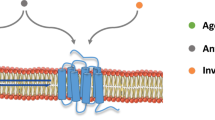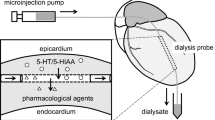Summary
Brain serotonin 5-HT1 and 5-HT2 binding properties were investigated in experimental chronic portal-systemic encephalopathy (PSE). Endto-side portacaval shunted (PCS) rats were subjected to open field behavioral testing (spontaneous activity and exploration) 3 weeks after the shunt procedure. Each individual animal was then assayed for 5-HT1 and 5-HT2 binding properties (Bmax and KD) in the cortex + hippocampus by the use of radioligand binding and rapid filtration technique. (3H)serotonin was used to label 5-HT1 binding sites and (3H)ketanserin to label 5-HT2 binding sites. Results revealed that the PCS rats exhibited significant behavioral changes with decreased spontaneous activity and exploratory behavior as compared with sham-operated controls (sham). The affinity for, and the number of, 5-HT1 and 5-HT2 binding sites, respectively, were not different between PCS and sham rats. The brain 5-HT1 and 5-HT2 binding porperties were within the range of Bmax and KD previously reported for normal rats when similar techniques are used. This first report in PCS rats on the subject of brain 5-HT1 and 5-HT2 binding properties demonstrates that no major alterations are likely to occur. This contrasts the knowledge of a markedly increased brain serotonin synthesis rate in the PCS rat, suggesting minor functional relevance of the perturbed brain serotonin metabolism associated with chronic PSE.
Similar content being viewed by others
References
Bengtsson F, Gage FH, Jeppsson B, Nobin A, Rosengren E (1985) Brain monamine metabolism and behavior in portacaval-shunted rats. Exp Neurol 90:21–35
Bengtsson F, Nobin A, Falck B, Gage FH, Jeppsson B (1986) Portacaval shunt in the rat: Selective alterations in behavior and brain serotonin. Pharmacol Biochem Behav 24:1611–1616
Bengtsson F, Bugge M, Brun A, Falck B, Henriksson K-G, Nobin A (1988) The impact of time after portacaval shunt in the rat on behavior, brain serotonin, and brain and muscle histology. J Neurol Sci 83:109–122
Blurton PA, Wood MD (1986) Identification of multiple binding sites for (3H)5-hydroxytryptamine in the rat CNS. J Neurochem 46:1392–1398
Bradley PB, Engel G, Feniuk W, Fozard JR, Humphrey PPA, Middlemiss DN, Mylecharane EJ, Richardson BP, Saxena PR (1986) Proposals for the classification and nomenclature of functional receptors for 5-hydroxytryptamine. Neuropharmacology 25:563–576
Conn HO, Lieberthal MM (1979) The hepatic coma syndromes and lactulose. Williams & Wilkins, Baltimore, pp 46–121
Doumas BT (1975) Standards for total serum protein assays — a collaborative study. Clin Chem 21:1159–1166
Fischer JE, Baldessarini RJ (1976) Pathogenesis and therapy of hepatic coma. Prog Liver Dis 5:363–397
Glowinski J (1975) Properties and functions of intraneuronal monoamine compartments in central aminergic neurons. In: Iversen LL, Iversen SD, Snyder SH (eds) Handbook of psychopharmacology. Plenum Press, New York, pp 136–167
Grahame-Smith DG (1973) Does the total turnover of brain 5-HT reflect the functional activity of 5-HT in brain? In: Barchas J, Usdin E (eds) Serotonin and behavior. Academic Press, New York, pp 5–7
Hall H, Wedel I (1985) The effect of manipulations of presynaptic 5-HT nerve terminals on postsynaptic 5-HT1 and 5-HT2 binding sites of the rat brain. J Neural Transm 64:129–143
Herrick-Davis K, Titeler M (1988) Detection and characterization of the serotonin 5-HT1D receptor in rat and human brain. J Neurochem 50:1624–1631
Holmin T, Siesjö BK (1974) The effect of porta-caval anastomosis upon the energy state and upon acid-base parameters of the rat brain. J Neurochem 22:403–412
Kienzl E, Riederer P, Jellinger K, Roth E, Ferenci P (1984) Modulation of serotonin receptors by L-valine in hepatic encephalopathy. In: Schlossberger et al. (eds) Progress in tryptophan and serotonin research. Walter de Gruyter, Berlin, pp 333–337
Kilpatrick GJ, Jones BJ, Tyers MB (1988) Identification and distribution of 5-HT3 receptors in rat brain using radioligand binding. Nature 330:746–748
Leysen JE (1985) Characterization of serotonin receptor binding sites. In: Green AR (ed) Neuropharmacology of serotonin. Oxford University Press, pp 79–116
Leysen JE, Niemegeers CJE, Van Nueten JM, Laduron PM (1982) (3H)Ketanserin (R 41468) a selective (3H)ligand for serotonin2 receptor binding sites. Mol Pharmacol 21:301–314
Lowry OH, Rosebrough MJ, Farr AL, Randall RJ (1951) Protein measurement with the folin phenol reagent. J Biol Chem 193:265–275
Martin JR, Baettig K, Bircher J (1980) Maze patrolling, open-field behavior and runway activity following experimental portacaval anastomosis in rats. Physiol Behav 25:713–719
Munson PJ, Rodbard D (1980) Ligand: A versatile computerized approach for the characterization of ligand binding systems. Anal Biochem 107:220–239
Peroutka SJ, Snyder SH (1979) Multiple serotonin receptors: Differential binding of (3H)5-hydroxytryptamine, (3H)lysergic acid diethylamide and (3H)spiroperidol. Mol Pharmacol 16:687–699
Riederer P, Kruzik P, Kienzl E, Kleinberger G, Jellinger K, Wesemann W (1984) Molecular aspects of neurotransmitter-receptor changes in hepatic encephalopathy. In: Kleinberger G, Ferenci P, Riederer P, Thaler H (eds) Advances in hepatic encephalopathy and urea cycle diseases. Karger, Basel, pp 373–384
Savage DD, Mendels J, Frazer A (1980) Monoamine oxidase inhibitors and serotonin uptake inhibitors: Differentiated effects on (3H)serotonin binding sites in rat brain. J Pharmacol Exp Ther 212:259–263
Scatchard G (1949) The attractions of proteins for small molecules and ions. Ann NY Acad Sci 51:660–672
Schröder R, Müller O, Bircher J (1985) The portacaval and splenocaval shunt in the normal rat. A morphological and functional reevaluation. J Hepatol 1:107–123
Shields PJ, Eccleston D (1973) Evidence for the synthesis and storage of 5-hydroxytryptamine in two separate pools in the brain. J Neurochem 20:881–888
Warbritton JD, Geyer MA, Jeppsson B, Fischer JE (1980) Decreased startle reactivity in the end-to-side portacaval shunted rat. Pharmacol Biochem Behav 12:739–742
Wesemann W, Weiner N, Rotsch M, Schulz E (1983) Serotonin binding in rat brain: Circadian rhythm and effect of sleep deprivation. J Neural Transm 18:287–294
Yamamura HI, Enna SJ, Kuhar MJ (1978) Neurotransmitter receptor binding. Raven Press, New York
Author information
Authors and Affiliations
Additional information
Financially supported by the Medical Faculty, Lund University, Sweden, the “Förenade Liv” Mutual Group Life Insurance Company, Stockholm, Sweden, the Swedish Society of Medicine, and the Swedish Medical Research Council (grants 12X-712 and 14X-56)
Rights and permissions
About this article
Cite this article
Bengtsson, F., Bugge, M., Hall, H. et al. Brain 5-HT1 and 5-HT2 binding sites following portacaval shunt in the rat. Res. Exp. Med. 189, 249–256 (1989). https://doi.org/10.1007/BF01852256
Received:
Accepted:
Issue Date:
DOI: https://doi.org/10.1007/BF01852256




